Abstract
Schistosoma mansoni adult worm 28-kilodalton (kDa) proteins were separated on polyacrylamide slab gels, recovered by electrophoretic elution, and used to immunize Fischer rats. After the second or third injection, inguinal lymph node T lymphocytes were propagated in vitro for 4 weeks in the presence of syngeneic antigen-presenting cells and adult worm antigens in medium containing interleukin-2. After this period of culture, 99% of the cells expressed the W3/13+ surface phenotype and 93% of the cells expressed the W3/25+ surface phenotype. These cells were then tested for their in vivo functional activity after transfer to Fischer rats that had been either infected with S. mansoni cercariae or immunized with the 28-kDa purified protein. In each case, an increase of S. mansoni-specific antibodies was observed. Whereas anti-28-kDa antibodies were only detectable at day 40 postinfection in controls injected with normal T lymphocytes, they appeared as early as day 13 postinfection when the animals received 28-kDa protein-specific T lymphocytes. This led to an effective protection of infected rats (45 to 85%) which correlated with the increase in S. mansoni-specific antibodies. These results therefore demonstrate that the 28-kDa protein possesses epitopes capable of activating helper T cells, which confer a strong protective immunity by enhancing the production of cytotoxic antibodies. The stimulation of the 28-kDa-specific T cells with recombinant proteins suggests that the major epitopes are located toward the carboxylic end of the molecule.
Full text
PDF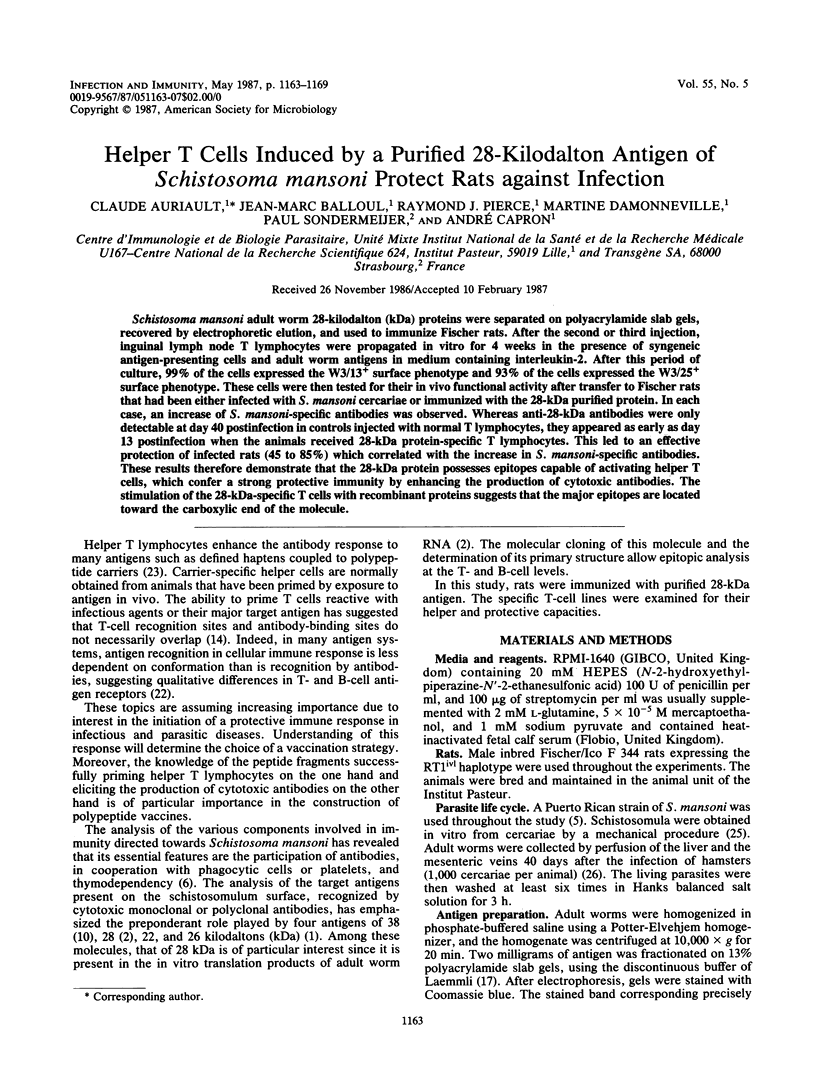
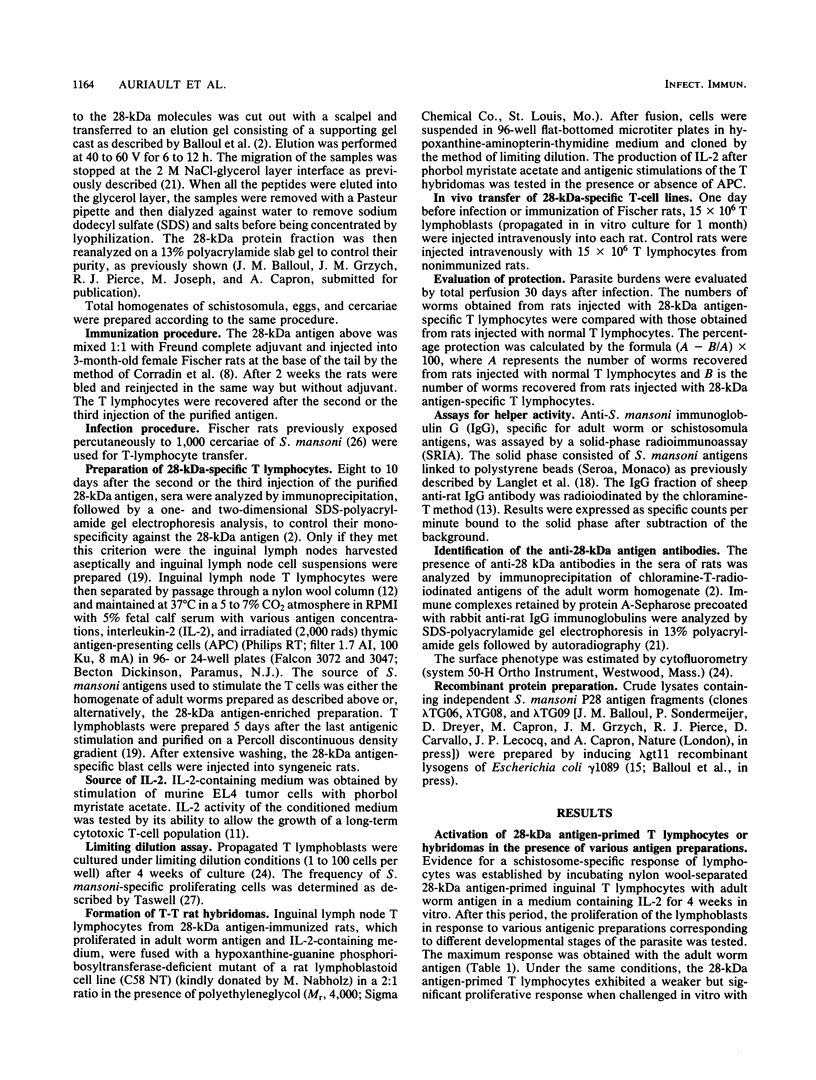
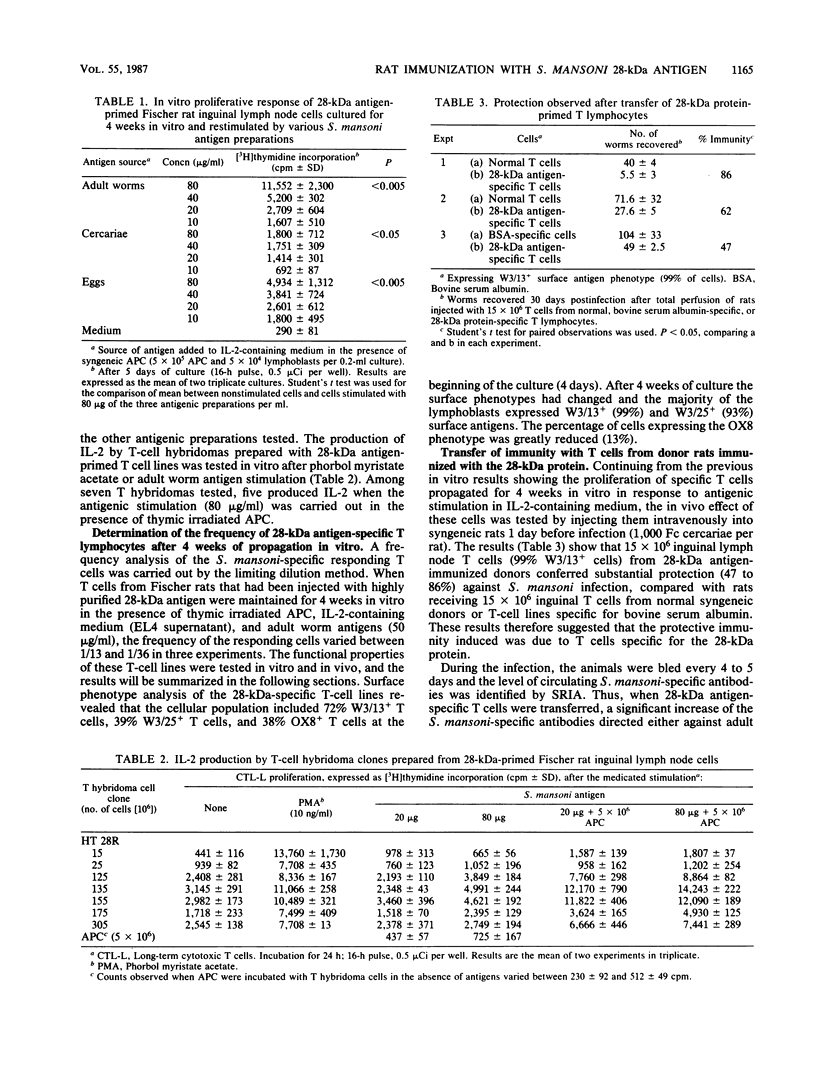
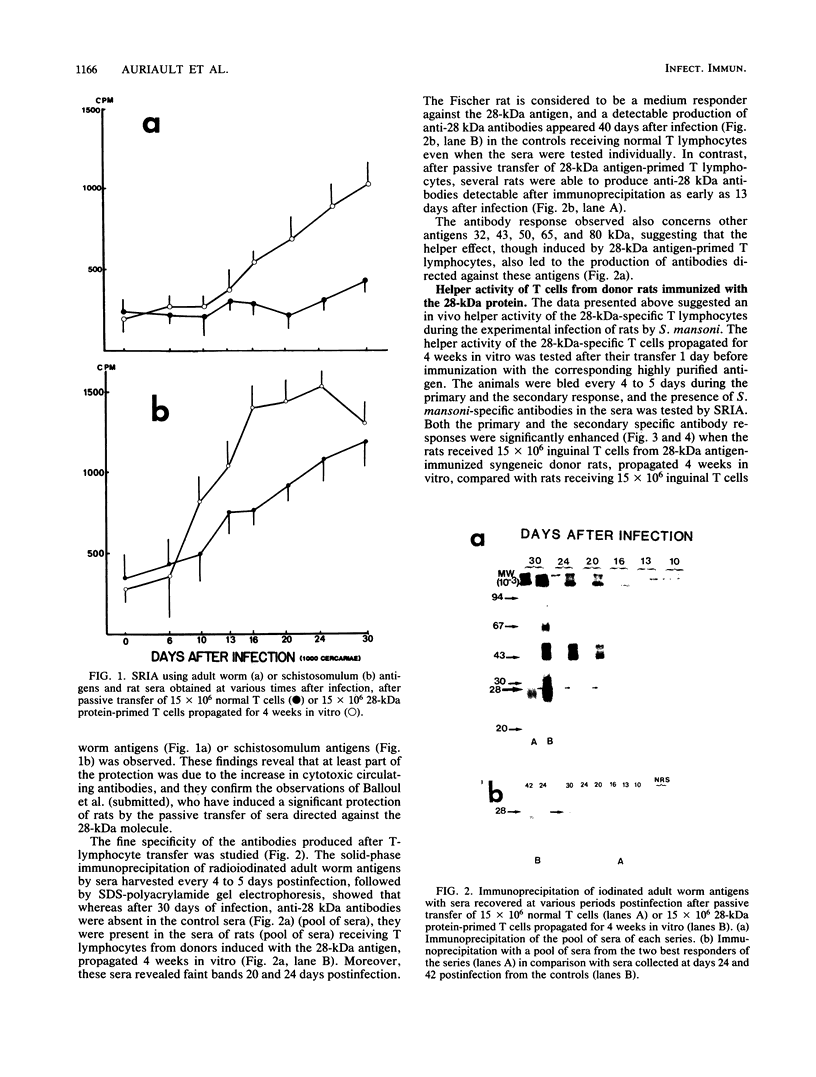
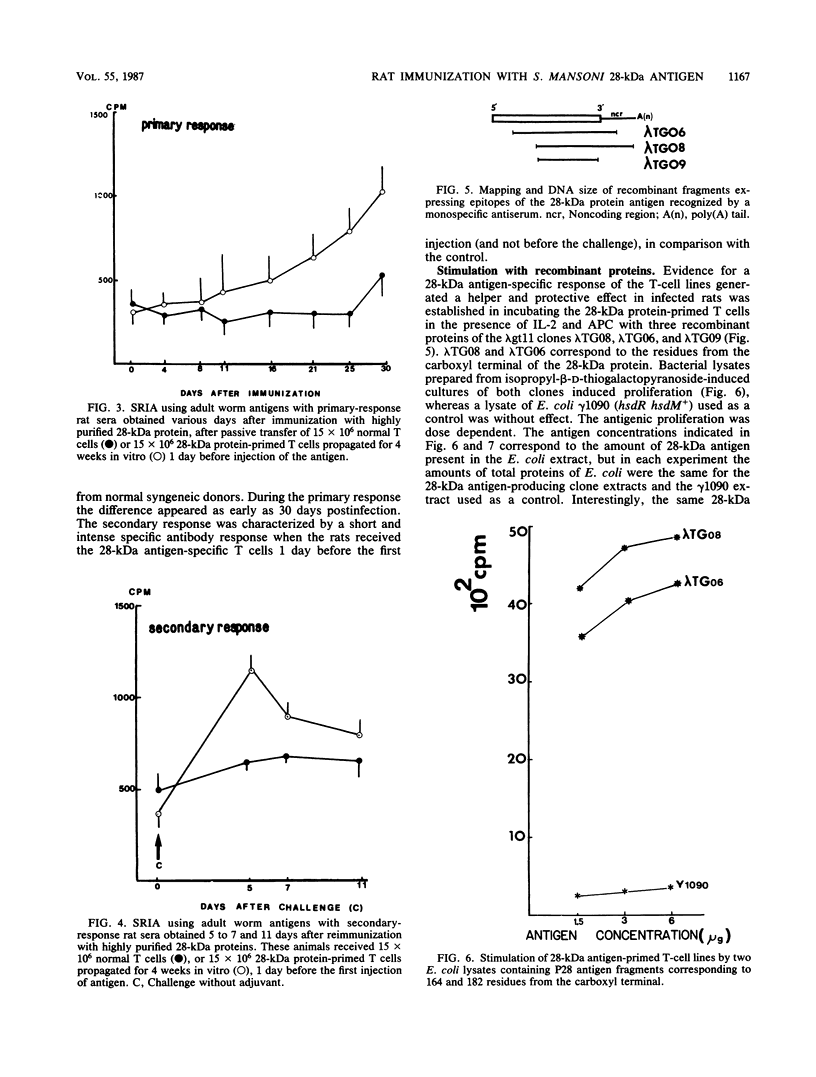
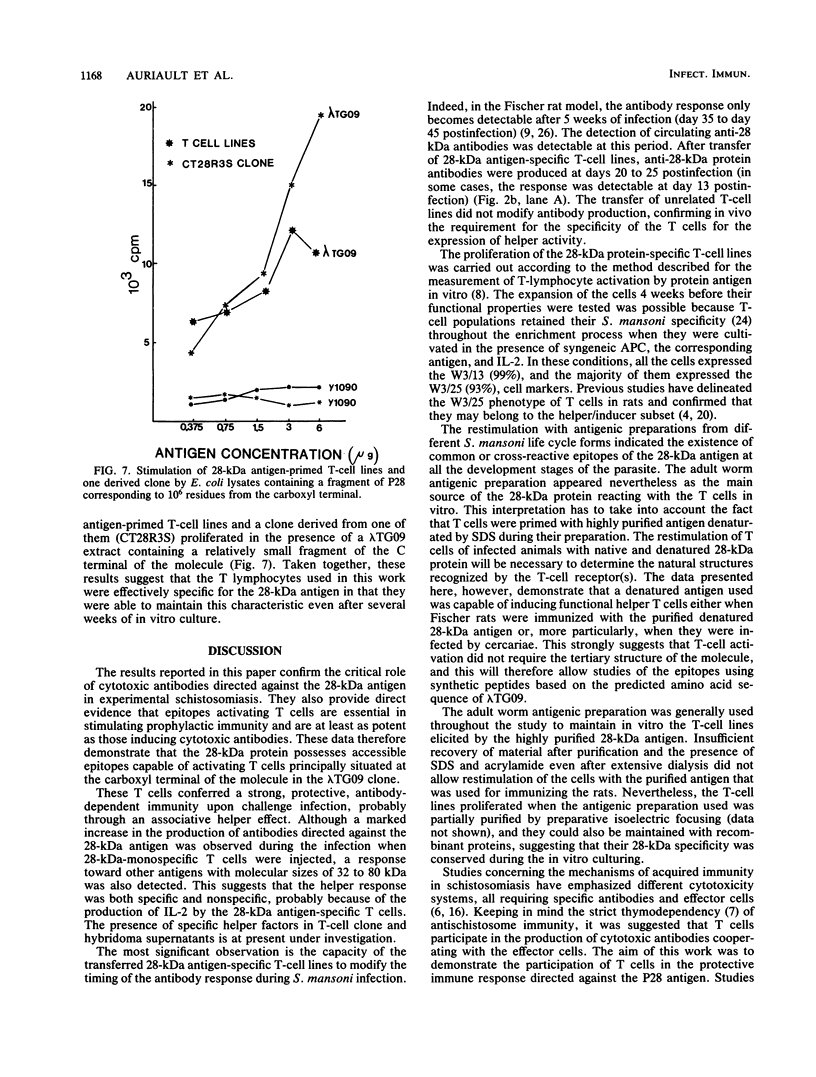
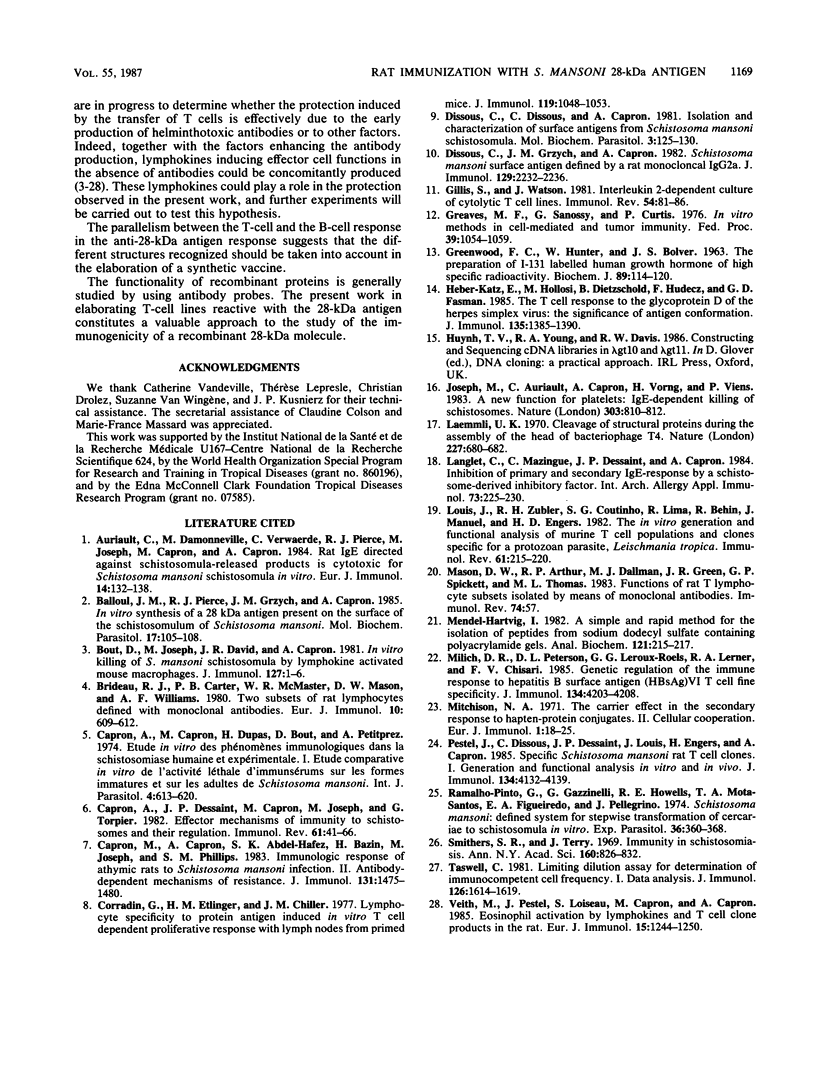
Images in this article
Selected References
These references are in PubMed. This may not be the complete list of references from this article.
- Auriault C., Damonneville M., Verwaerde C., Pierce R., Joseph M., Capron M., Capron A. Rat IgE directed against schistosomula-released products is cytotoxic for Schistosoma mansoni schistosomula in vitro. Eur J Immunol. 1984 Feb;14(2):132–138. doi: 10.1002/eji.1830140206. [DOI] [PubMed] [Google Scholar]
- Balloul J. M., Pierce R. J., Grzych J. M., Capron A. In vitro synthesis of a 28 kilodalton antigen present on the surface of the schistosomulum of Schistosoma mansoni. Mol Biochem Parasitol. 1985 Oct;17(1):105–114. doi: 10.1016/0166-6851(85)90131-8. [DOI] [PubMed] [Google Scholar]
- Bout D. T., Joseph M., David J. R., Capron A. R. In vitro killing of S. mansoni schistosomula by lymphokine-activated mouse macrophages. J Immunol. 1981 Jul;127(1):1–5. [PubMed] [Google Scholar]
- Brideau R. J., Carter P. B., McMaster W. R., Mason D. W., Williams A. F. Two subsets of rat T lymphocytes defined with monoclonal antibodies. Eur J Immunol. 1980 Aug;10(8):609–615. doi: 10.1002/eji.1830100807. [DOI] [PubMed] [Google Scholar]
- Capron A., Capron M., Dupas H., Bout D., Petitprez A. Etude in vitro des phénomènes immunologiques dans la schistosomiase humaine et expérimentale. I. Etude comparative in vitro de l'activité léthale d'immunsérums sur les formes immatures et sur les adultes de Schistosoma mansoni. Int J Parasitol. 1974 Dec;4(6):613–623. doi: 10.1016/0020-7519(74)90026-5. [DOI] [PubMed] [Google Scholar]
- Capron A., Dessaint J. P., Capron M., Joseph M., Torpier G. Effector mechanisms of immunity to schistosomes and their regulation. Immunol Rev. 1982;61:41–66. doi: 10.1111/j.1600-065x.1982.tb00373.x. [DOI] [PubMed] [Google Scholar]
- Capron M., Capron A., Abdel-Hafez S. K., Bazin H., Joseph M., Phillips S. M. Immunologic response of athymic rats to Schistosoma mansoni infection. II. Antibody-dependent mechanisms of resistance. J Immunol. 1983 Sep;131(3):1475–1480. [PubMed] [Google Scholar]
- Corradin G., Etlinger H. M., Chiller J. M. Lymphocyte specificity to protein antigens. I. Characterization of the antigen-induced in vitro T cell-dependent proliferative response with lymph node cells from primed mice. J Immunol. 1977 Sep;119(3):1048–1053. [PubMed] [Google Scholar]
- Dissous C., Grzych J. M., Capron A. Schistosoma mansoni surface antigen defined by a rat monoclonal IgG2a. J Immunol. 1982 Nov;129(5):2232–2234. [PubMed] [Google Scholar]
- GREENWOOD F. C., HUNTER W. M., GLOVER J. S. THE PREPARATION OF I-131-LABELLED HUMAN GROWTH HORMONE OF HIGH SPECIFIC RADIOACTIVITY. Biochem J. 1963 Oct;89:114–123. doi: 10.1042/bj0890114. [DOI] [PMC free article] [PubMed] [Google Scholar]
- Gillis S., Watson J. Interleukin-2 dependent culture of cytolytic T cell lines. Immunol Rev. 1981;54:81–109. doi: 10.1111/j.1600-065x.1981.tb00435.x. [DOI] [PubMed] [Google Scholar]
- Heber-Katz E., Hollosi M., Dietzschold B., Hudecz F., Fasman G. D. The T cell response to the glycoprotein D of the herpes simplex virus: the significance of antigen conformation. J Immunol. 1985 Aug;135(2):1385–1390. [PubMed] [Google Scholar]
- Joseph M., Auriault C., Capron A., Vorng H., Viens P. A new function for platelets: IgE-dependent killing of schistosomes. Nature. 1983 Jun 30;303(5920):810–812. doi: 10.1038/303810a0. [DOI] [PubMed] [Google Scholar]
- Laemmli U. K. Cleavage of structural proteins during the assembly of the head of bacteriophage T4. Nature. 1970 Aug 15;227(5259):680–685. doi: 10.1038/227680a0. [DOI] [PubMed] [Google Scholar]
- Langlet C., Mazingue C., Dessaint J. P., Capron A. Inhibition of primary and secondary IgE-response by a schistosome-derived inhibitory factor. Int Arch Allergy Appl Immunol. 1984;73(3):225–230. doi: 10.1159/000233472. [DOI] [PubMed] [Google Scholar]
- Louis J. A., Zubler R. H., Coutinho S. G., Lima G., Behin R., Mauel J., Engers H. D. The in vitro generation and functional analysis of murine T cell populations and clones specific for a protozoan parasite, Leishmania tropica. Immunol Rev. 1982;61:215–243. doi: 10.1111/j.1600-065x.1982.tb00378.x. [DOI] [PubMed] [Google Scholar]
- Mason D. W., Arthur R. P., Dallman M. J., Green J. R., Spickett G. P., Thomas M. L. Functions of rat T-lymphocyte subsets isolated by means of monoclonal antibodies. Immunol Rev. 1983;74:57–82. doi: 10.1111/j.1600-065x.1983.tb01084.x. [DOI] [PubMed] [Google Scholar]
- Mendel-Hartvig I. B. A simple and rapid method for the isolation of peptides from sodium dodecyl sulfate-containing polyacrylamide gels. Anal Biochem. 1982 Mar 15;121(1):215–217. doi: 10.1016/0003-2697(82)90579-6. [DOI] [PubMed] [Google Scholar]
- Milich D. R., Peterson D. L., Leroux-Roels G. G., Lerner R. A., Chisari F. V. Genetic regulation of the immune response to hepatitis B surface antigen (HBsAg). VI. T cell fine specificity. J Immunol. 1985 Jun;134(6):4203–4211. [PubMed] [Google Scholar]
- Mitchison N. A. The carrier effect in the secondary response to hapten-protein conjugates. II. Cellular cooperation. Eur J Immunol. 1971 Jan;1(1):18–27. doi: 10.1002/eji.1830010104. [DOI] [PubMed] [Google Scholar]
- Pestel J., Dissous C., Dessaint J. P., Louis J., Engers H., Capron A. Specific Schistosoma mansoni rat T cell clones. I. Generation and functional analysis in vitro and in vivo. J Immunol. 1985 Jun;134(6):4132–4139. [PubMed] [Google Scholar]
- Ramalho-Pinto F. J., Gazzinelli G., Howells R. E., Mota-Santos T. A., Figueiredo E. A., Pellegrino J. Schistosoma mansoni: defined system for stepwise transformation of cercaria to schistosomule in vitro. Exp Parasitol. 1974 Dec;36(3):360–372. doi: 10.1016/0014-4894(74)90076-9. [DOI] [PubMed] [Google Scholar]
- Smithers S. R., Terry R. J. Immunity in schistosomiasis. Ann N Y Acad Sci. 1969 Oct 6;160(2):826–840. doi: 10.1111/j.1749-6632.1969.tb15904.x. [DOI] [PubMed] [Google Scholar]
- Taswell C. Limiting dilution assays for the determination of immunocompetent cell frequencies. I. Data analysis. J Immunol. 1981 Apr;126(4):1614–1619. [PubMed] [Google Scholar]
- Veith M., Pestel J., Loiseau S., Capron M., Capron A. Eosinophil activation by lymphokines and T cell clone products in the rat. Eur J Immunol. 1985 Dec;15(12):1244–1250. doi: 10.1002/eji.1830151218. [DOI] [PubMed] [Google Scholar]



